Hyundai Coupe 2002 Owner's Manual
Manufacturer: HYUNDAI, Model Year: 2002, Model line: Coupe, Model: Hyundai Coupe 2002Pages: 140, PDF Size: 1.45 MB
Page 121 of 140
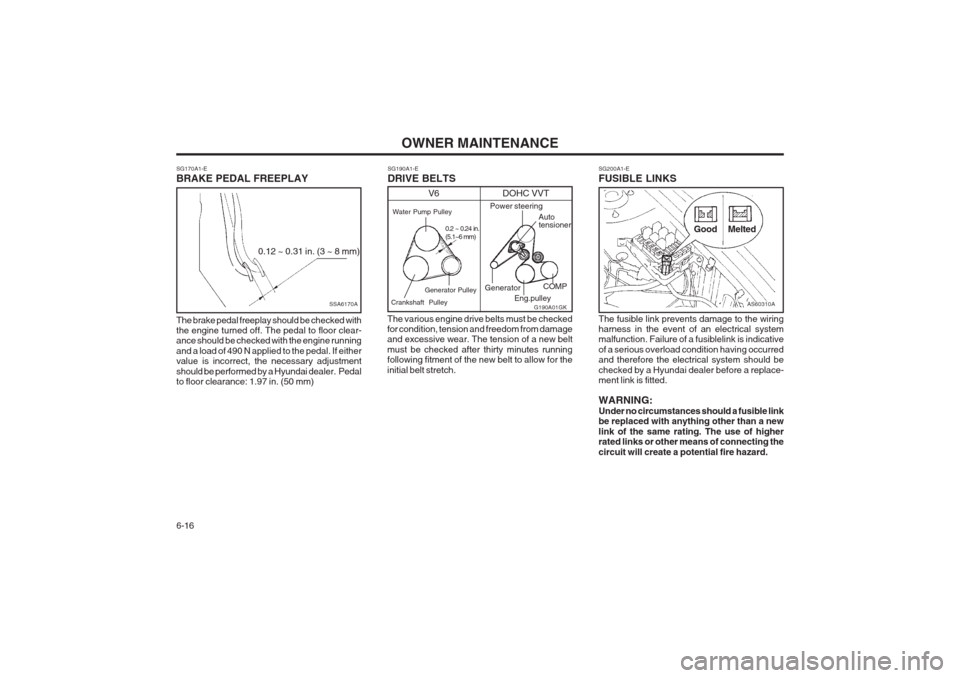
OWNER MAINTENANCE
6-16
SG170A1-E BRAKE PEDAL FREEPLAY
SSA6170A
0.12 ~ 0.31 in. (3 ~ 8 mm)
The brake pedal freeplay should be checked with the engine turned off. The pedal to floor clear-ance should be checked with the engine running and a load of 490 N applied to the pedal. If either value is incorrect, the necessary adjustment should be performed by a Hyundai dealer. Pedal to floor clearance: 1.97 in. (50 mm) SG190A1-E DRIVE BELTS
The various engine drive belts must be checked for condition, tension and freedom from damageand excessive wear. The tension of a new belt must be checked after thirty minutes running following fitment of the new belt to allow for the initial belt stretch. SG200A1-E FUSIBLE LINKS
AS60310A
Melted
Good
The fusible link prevents damage to the wiring harness in the event of an electrical systemmalfunction. Failure of a fusiblelink is indicative of a serious overload condition having occurred and therefore the electrical system should be checked by a Hyundai dealer before a replace- ment link is fitted. WARNING: Under no circumstances should a fusible link be replaced with anything other than a new link of the same rating. The use of higher rated links or other means of connecting the circuit will create a potential fire hazard.G190A01GK
V6 DOHC VVT
Water Pump Pulley
Generator Pulley
Crankshaft Pulley 0.2 ~ 0.24 in. (5.1~6 mm)
Power steering
Auto tensioner
GeneratorEng.pulleyCOMP
Page 122 of 140
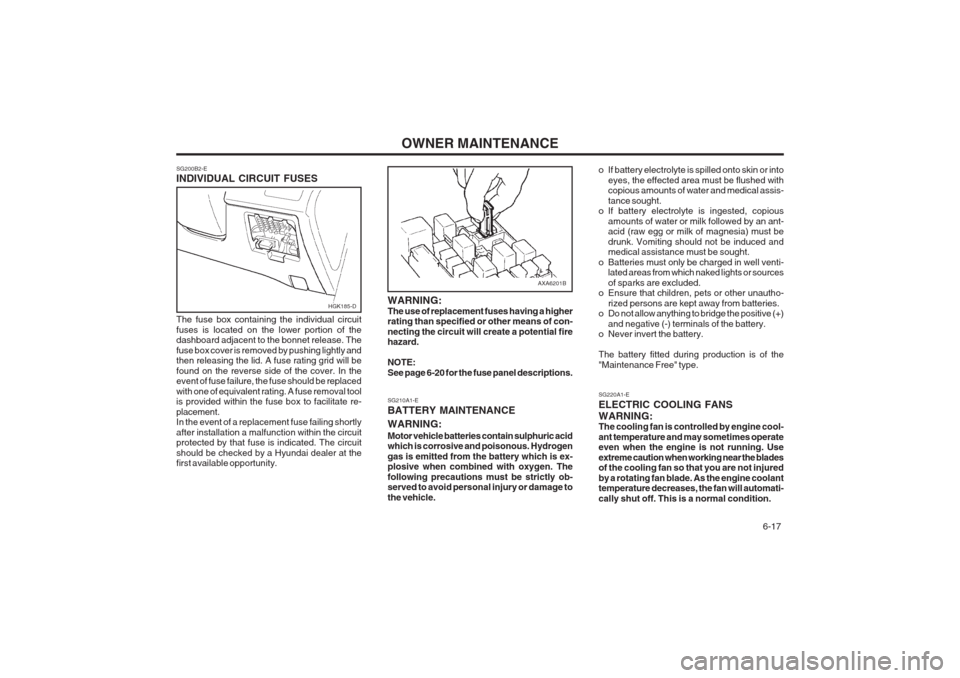
OWNER MAINTENANCE 6-17
SG200B2-E INDIVIDUAL CIRCUIT FUSES The fuse box containing the individual circuit fuses is located on the lower portion of the dashboard adjacent to the bonnet release. The fuse box cover is removed by pushing lightly and then releasing the lid. A fuse rating grid will be found on the reverse side of the cover. In the event of fuse failure, the fuse should be replaced with one of equivalent rating. A fuse removal tool is provided within the fuse box to facilitate re- placement. In the event of a replacement fuse failing shortly after installation a malfunction within the circuit protected by that fuse is indicated. The circuit should be checked by a Hyundai dealer at the first available opportunity.
AXA6201B
WARNING: The use of replacement fuses having a higher rating than specified or other means of con- necting the circuit will create a potential fire hazard. NOTE: See page 6-20 for the fuse panel descriptions. SG210A1-E BATTERY MAINTENANCE WARNING: Motor vehicle batteries contain sulphuric acid which is corrosive and poisonous. Hydrogen gas is emitted from the battery which is ex- plosive when combined with oxygen. The following precautions must be strictly ob- served to avoid personal injury or damage to the vehicle.
HGK185-D
SG220A1-E ELECTRIC COOLING FANSWARNING: The cooling fan is controlled by engine cool- ant temperature and may sometimes operate even when the engine is not running. Use extreme caution when working near the blades of the cooling fan so that you are not injured by a rotating fan blade. As the engine coolant temperature decreases, the fan will automati- cally shut off. This is a normal condition.
o If battery electrolyte is spilled onto skin or into
eyes, the effected area must be flushed with copious amounts of water and medical assis- tance sought.
o If battery electrolyte is ingested, copious
amounts of water or milk followed by an ant- acid (raw egg or milk of magnesia) must be drunk. Vomiting should not be induced and medical assistance must be sought.
o Batteries must only be charged in well venti- lated areas from which naked lights or sources of sparks are excluded.
o Ensure that children, pets or other unautho-
rized persons are kept away from batteries.
o Do not allow anything to bridge the positive (+)
and negative (-) terminals of the battery.
o Never invert the battery. The battery fitted during production is of the "Maintenance Free" type.
Page 123 of 140
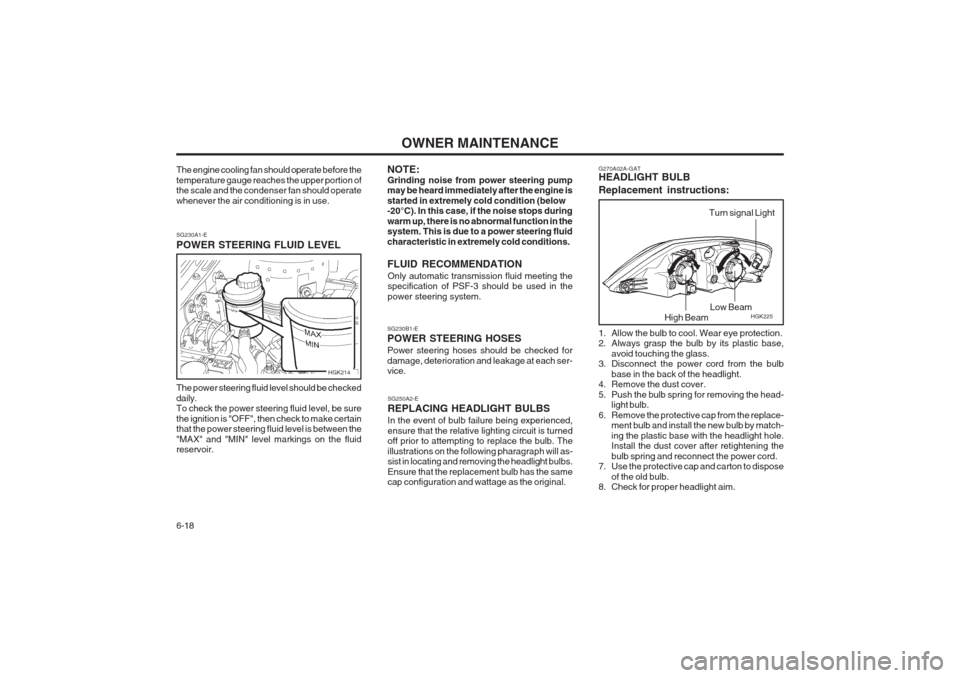
OWNER MAINTENANCE
6-18 NOTE: Grinding noise from power steering pump may be heard immediately after the engine is started in extremely cold condition (below -20°C). In this case, if the noise stops during warm up, there is no abnormal function in the system. This is due to a power steering fluid characteristic in extremely cold conditions. FLUID RECOMMENDATION
Only automatic transmission fluid meeting the specification of PSF-3 should be used in the power steering system.
SG230A1-E POWER STEERING FLUID LEVEL The power steering fluid level should be checked daily. To check the power steering fluid level, be sure the ignition is "OFF", then check to make certain that the power steering fluid level is between the "MAX" and "MIN" level markings on the fluid reservoir.
SG250A2-E REPLACING HEADLIGHT BULBS In the event of bulb failure being experienced, ensure that the relative lighting circuit is turned off prior to attempting to replace the bulb. The illustrations on the following pharagraph will as- sist in locating and removing the headlight bulbs. Ensure that the replacement bulb has the same cap configuration and wattage as the original.
SG230B1-E POWER STEERING HOSES Power steering hoses should be checked for damage, deterioration and leakage at each ser- vice.
The engine cooling fan should operate before the temperature gauge reaches the upper portion of the scale and the condenser fan should operate whenever the air conditioning is in use.
HGK214 G270A02A-GAT HEADLIGHT BULB Replacement instructions:
HGK225
1. Allow the bulb to cool. Wear eye protection.
2. Always grasp the bulb by its plastic base, avoid touching the glass.
3. Disconnect the power cord from the bulb
base in the back of the headlight.
4. Remove the dust cover.
5. Push the bulb spring for removing the head- light bulb.
6. Remove the protective cap from the replace- ment bulb and install the new bulb by match-ing the plastic base with the headlight hole. Install the dust cover after retightening the bulb spring and reconnect the power cord.
7. Use the protective cap and carton to dispose
of the old bulb.
8. Check for proper headlight aim.High Beam Low Beam
Turn signal Light
Page 124 of 140
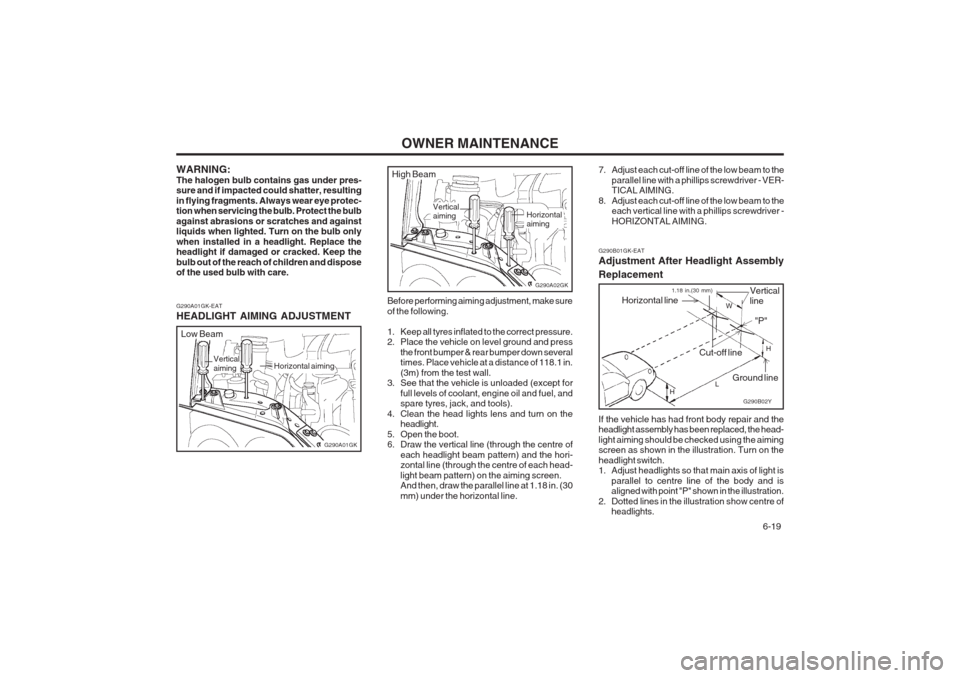
OWNER MAINTENANCE 6-19
G290A01GK-EAT HEADLIGHT AIMING ADJUSTMENT
Before performing aiming adjustment, make sure of the following.
1. Keep all tyres inflated to the correct pressure.
2. Place the vehicle on level ground and press
the front bumper & rear bumper down severaltimes. Place vehicle at a distance of 118.1 in. (3m) from the test wall.
3. See that the vehicle is unloaded (except for
full levels of coolant, engine oil and fuel, and spare tyres, jack, and tools).
4. Clean the head lights lens and turn on the headlight.
5. Open the boot.
6. Draw the vertical line (through the centre of each headlight beam pattern) and the hori-zontal line (through the centre of each head- light beam pattern) on the aiming screen. And then, draw the parallel line at 1.18 in. (30 mm) under the horizontal line.
WARNING:The halogen bulb contains gas under pres- sure and if impacted could shatter, resulting in flying fragments. Always wear eye protec- tion when servicing the bulb. Protect the bulb against abrasions or scratches and against liquids when lighted. Turn on the bulb only when installed in a headlight. Replace the headlight if damaged or cracked. Keep the bulb out of the reach of children and dispose of the used bulb with care.
Vertical aiming
G290A01GK
Horizontal aiming
Low Beam
Vertical aiming
G290A02GK
Horizontal aiming
High Beam
7. Adjust each cut-off line of the low beam to the
parallel line with a phillips screwdriver - VER- TICAL AIMING.
8. Adjust each cut-off line of the low beam to the each vertical line with a phillips screwdriver - HORIZONTAL AIMING.
G290B01GK-EAT Adjustment After Headlight Assembly Replacement
G290B02Y
Vertical line
Cut-off line Ground line
Horizontal line
LW
H
H "P"1.18 in.(30 mm)
If the vehicle has had front body repair and the headlight assembly has been replaced, the head- light aiming should be checked using the aiming screen as shown in the illustration. Turn on the headlight switch.
1. Adjust headlights so that main axis of light is parallel to centre line of the body and isaligned with point "P" shown in the illustration.
2. Dotted lines in the illustration show centre of headlights.
Page 125 of 140
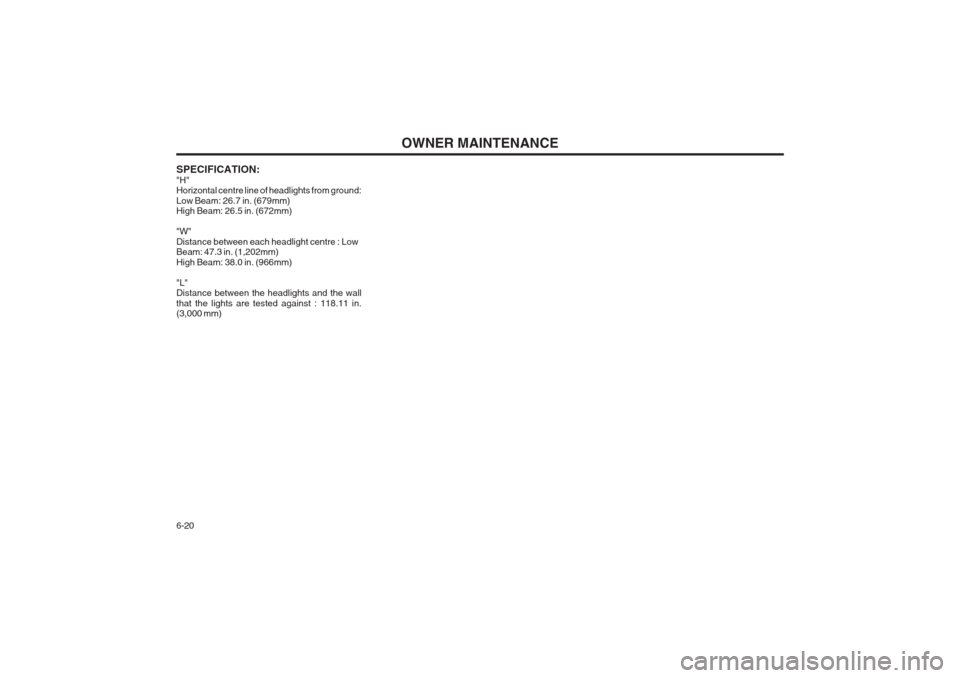
OWNER MAINTENANCE
6-20
SPECIFICATION: "H" Horizontal centre line of headlights from ground: Low Beam: 26.7 in. (679mm) High Beam: 26.5 in. (672mm) "W" Distance between each headlight centre : Low Beam: 47.3 in. (1,202mm) High Beam: 38.0 in. (966mm) "L" Distance between the headlights and the wall that the lights are tested against : 118.11 in. (3,000 mm)
Page 126 of 140
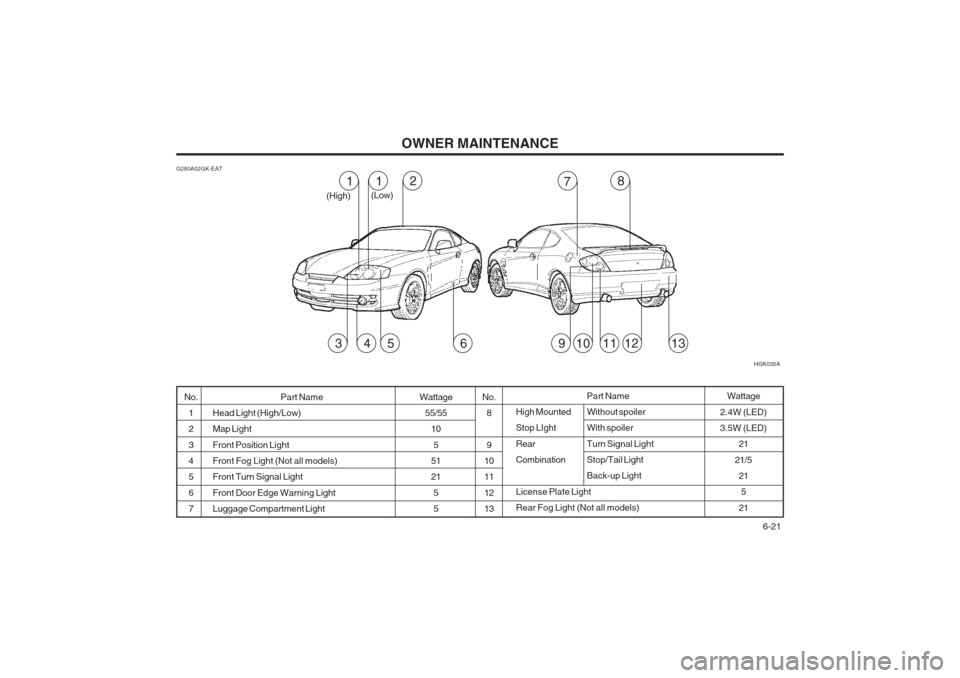
OWNER MAINTENANCE 6-21
Wattage
55/55 10
5
51 21
55
G280A02GK-EAT
Part Name
Head Light (High/Low) Map Light Front Position Light Front Fog Light (Not all models)Front Turn Signal Light Front Door Edge Warning Light Luggage Compartment Light
No.
12 3 45 6 7 No.
8 9
10 11 12 13 Part Name
High Mounted Without spoiler
Stop LIght With spoiler Rear Turn Signal Light
Combination Stop/Tail Light Back-up Light
License Plate LightRear Fog Light (Not all models)Wattage
2.4W (LED) 3.5W (LED) 21
21/5 215
21
5111213346
HGK035A
1182
(High) (Low)
109
7
Page 127 of 140
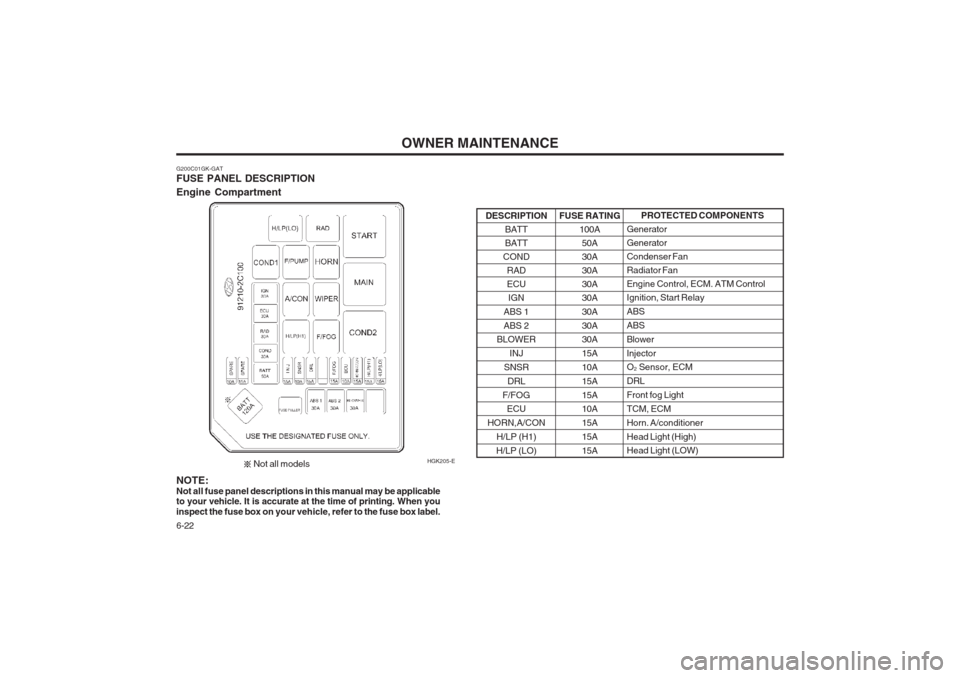
OWNER MAINTENANCE
6-22
G200C01GK-GAT FUSE PANEL DESCRIPTION Engine Compartment HGK205-EPROTECTED COMPONENTS
GeneratorGeneratorCondenser FanRadiator FanEngine Control, ECM. ATM ControlIgnition, Start Relay ABSABSBlowerInjector O 2 Sensor, ECM
DRL Front fog LightTCM, ECMHorn. A/conditionerHead Light (High) Head Light (LOW)
FUSE RATING
100A50A30A30A30A30A 30A30A 30A 15A10A15A15A 10A 15A15A15A
DESCRIPTION
BATT BATT
COND RADECUIGN
ABS 1 ABS 2
BLOWER
INJ
SNSR DRL
F/FOG ECU
HORN,A/CON H/LP (H1)
H/LP (LO)
NOTE:
Not all fuse panel descriptions in this manual may be applicable
to your vehicle. It is accurate at the time of printing. When youinspect the fuse box on you r vehicle, refer to the fuse box label.
Not all models
Page 128 of 140
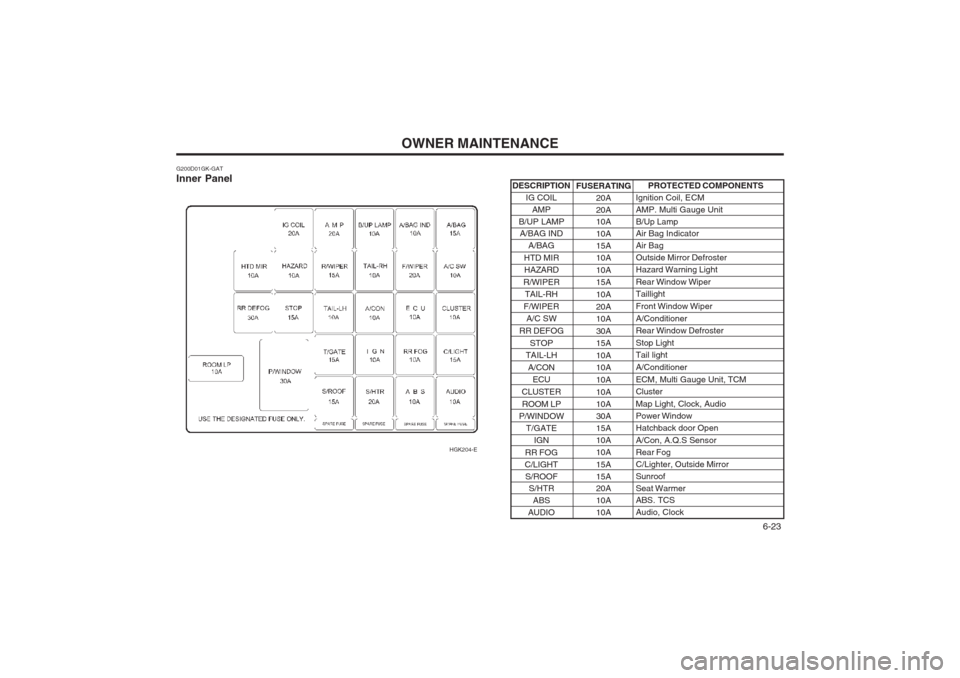
OWNER MAINTENANCE 6-23
DESCRIPTION
IG COILAMP
B/UP LAMP A/BAG IND
A/BAG
HTD MIR HAZARD
R/WIPER TAIL-RH
F/WIPER A/C SW
RR DEFOG STOP
TAIL-LH
A/CON ECU
CLUSTER ROOM LP
P/WINDOW T/GATE IGN
RR FOG
C/LIGHT S/ROOF S/HTR
ABS
AUDIO
G200D01GK-GAT Inner Panel
HGK204-E
PROTECTED COMPONENTS
Ignition Coil, ECM
AMP. Multi Gauge UnitB/Up Lamp Air Bag Indicator Air BagOutside Mirror DefrosterHazard Warning Light Rear Window Wiper Taillight Front Window WiperA/Conditioner Rear Window Defroster Stop Light Tail light A/Conditioner
ECM, Multi Gauge Unit, TCM Cluster Map Light, Clock, Audio Power WindowHatchback door Open A/Con, A.Q.S Sensor Rear FogC/Lighter, Outside MirrorSunroofSeat Warmer ABS. TCS Audio, Clock
FUSERATING
20A20A 10A 10A15A10A 10A 15A 10A20A 10A 30A 15A 10A 10A 10A10A 10A30A15A10A10A 15A 15A 20A 10A10A
Page 129 of 140
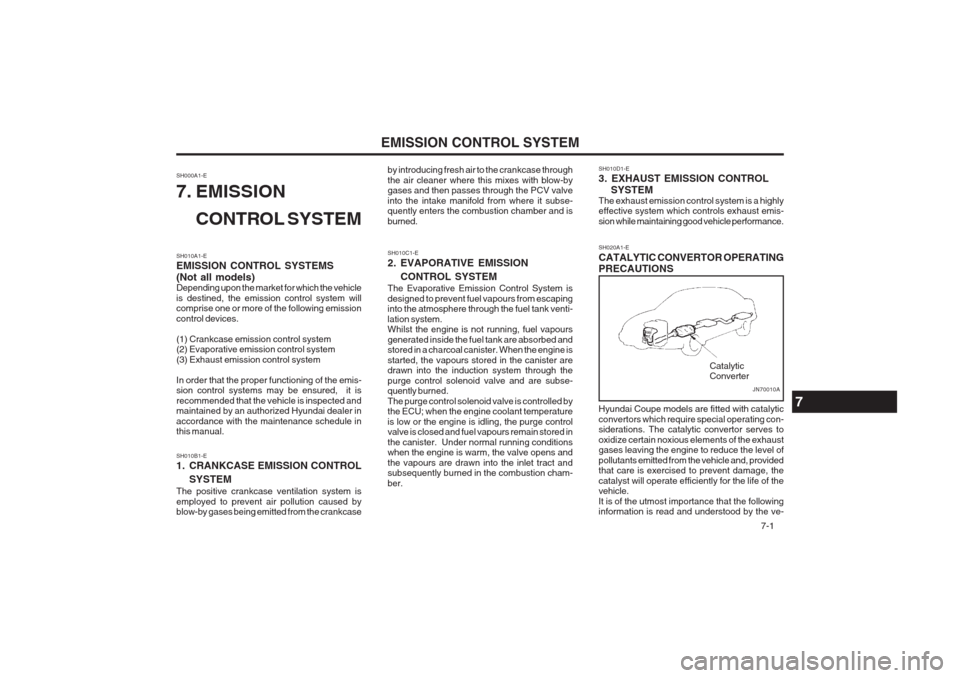
EMISSION CONTROL SYSTEM 7-1
SH010A1-E EMISSION CONTROL SYSTEMS (Not all models) Depending upon the market for which the vehicle is destined, the emission control system will comprise one or more of the following emission control devices. (1) Crankcase emission control system (2) Evaporative emission control system (3) Exhaust emission control system In order that the proper functioning of the emis- sion control systems may be ensured, it is recommended that the vehicle is inspected and maintained by an authorized Hyundai dealer in accordance with the maintenance schedule in this manual.
SH000A1-E
7. EMISSION
CONTROL SYSTEM
SH010B1-E
1. CRANKCASE EMISSION CONTROL SYSTEM
The positive crankcase ventilation system is employed to prevent air pollution caused by blow-by gases being emitted from the crankcase by introducing fresh air to the crankcase through the air cleaner where this mixes with blow-by gases and then passes through the PCV valve into the intake manifold from where it subse- quently enters the combustion chamber and is burned.
SH010D1-E
3. EXHAUST EMISSION CONTROL SYSTEM The exhaust emission control system is a highly effective system which controls exhaust emis- sion while maintaining good vehicle performance.
SH010C1-E
2. EVAPORATIVE EMISSION CONTROL SYSTEM
The Evaporative Emission Control System is designed to prevent fuel vapours from escaping into the atmosphere through the fuel tank venti- lation system. Whilst the engine is not running, fuel vapours generated inside the fuel tank are absorbed and stored in a charcoal canister. When the engine is started, the vapours stored in the canister are drawn into the induction system through the purge control solenoid valve and are subse- quently burned. The purge control solenoid valve is controlled by the ECU; when the engine coolant temperature is low or the engine is idling, the purge control valve is closed and fuel vapours remain stored in the canister. Under normal running conditions when the engine is warm, the valve opens and the vapours are drawn into the inlet tract and subsequently burned in the combustion cham- ber. SH020A1-E CATALYTIC CONVERTOR OPERATING PRECAUTIONS
JN70010A
Catalytic Converter
Hyundai Coupe models are fitted with catalytic convertors which require special operating con- siderations. The catalytic convertor serves to oxidize certain noxious elements of the exhaust gases leaving the engine to reduce the level of pollutants emitted from the vehicle and, provided that care is exercised to prevent damage, the catalyst will operate efficiently for the life of the vehicle. It is of the utmost importance that the following information is read and understood by the ve-7
Page 130 of 140
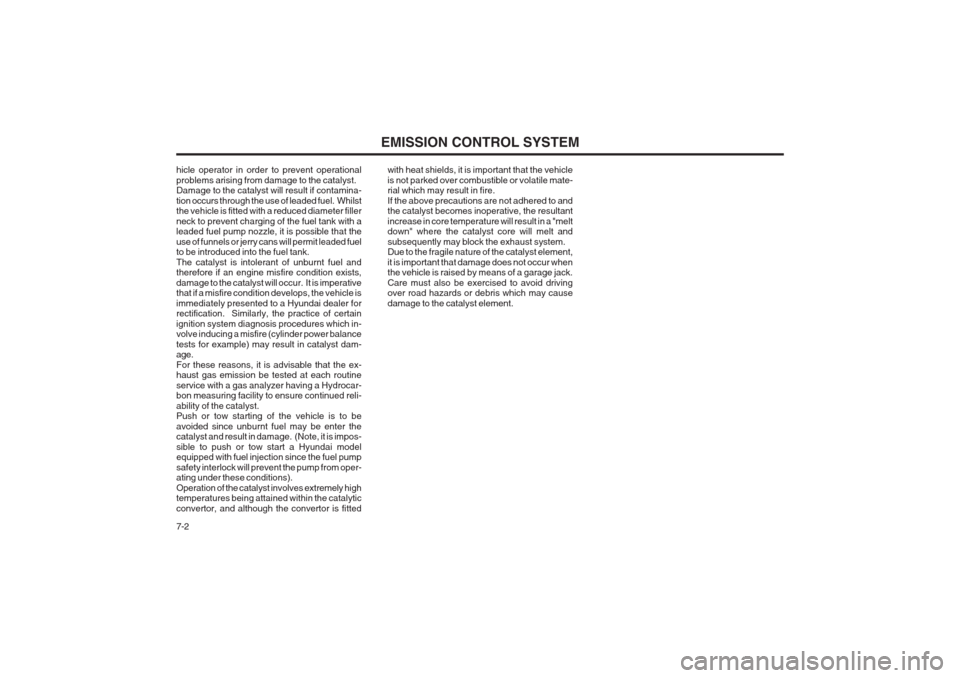
EMISSION CONTROL SYSTEM
7-2
hicle operator in order to prevent operational problems arising from damage to the catalyst. Damage to the catalyst will result if contamina- tion occurs through the use of leaded fuel. Whilst the vehicle is fitted with a reduced diameter filler neck to prevent charging of the fuel tank with a leaded fuel pump nozzle, it is possible that the use of funnels or jerry cans will permit leaded fuel to be introduced into the fuel tank. The catalyst is intolerant of unburnt fuel and therefore if an engine misfire condition exists, damage to the catalyst will occur. It is imperative that if a misfire condition develops, the vehicle is immediately presented to a Hyundai dealer for rectification. Similarly, the practice of certain ignition system diagnosis procedures which in- volve inducing a misfire (cylinder power balance tests for example) may result in catalyst dam- age. For these reasons, it is advisable that the ex- haust gas emission be tested at each routine service with a gas analyzer having a Hydrocar- bon measuring facility to ensure continued reli- ability of the catalyst. Push or tow starting of the vehicle is to be avoided since unburnt fuel may be enter the catalyst and result in damage. (Note, it is impos- sible to push or tow start a Hyundai model equipped with fuel injection since the fuel pump safety interlock will prevent the pump from oper- ating under these conditions). Operation of the catalyst involves extremely high temperatures being attained within the catalytic convertor, and although the convertor is fitted
with heat shields, it is important that the vehicleis not parked over combustible or volatile mate- rial which may result in fire. If the above precautions are not adhered to and the catalyst becomes inoperative, the resultant increase in core temperature will result in a "melt down" where the catalyst core will melt and subsequently may block the exhaust system. Due to the fragile nature of the catalyst element, it is important that damage does not occur when the vehicle is raised by means of a garage jack. Care must also be exercised to avoid driving over road hazards or debris which may cause damage to the catalyst element.